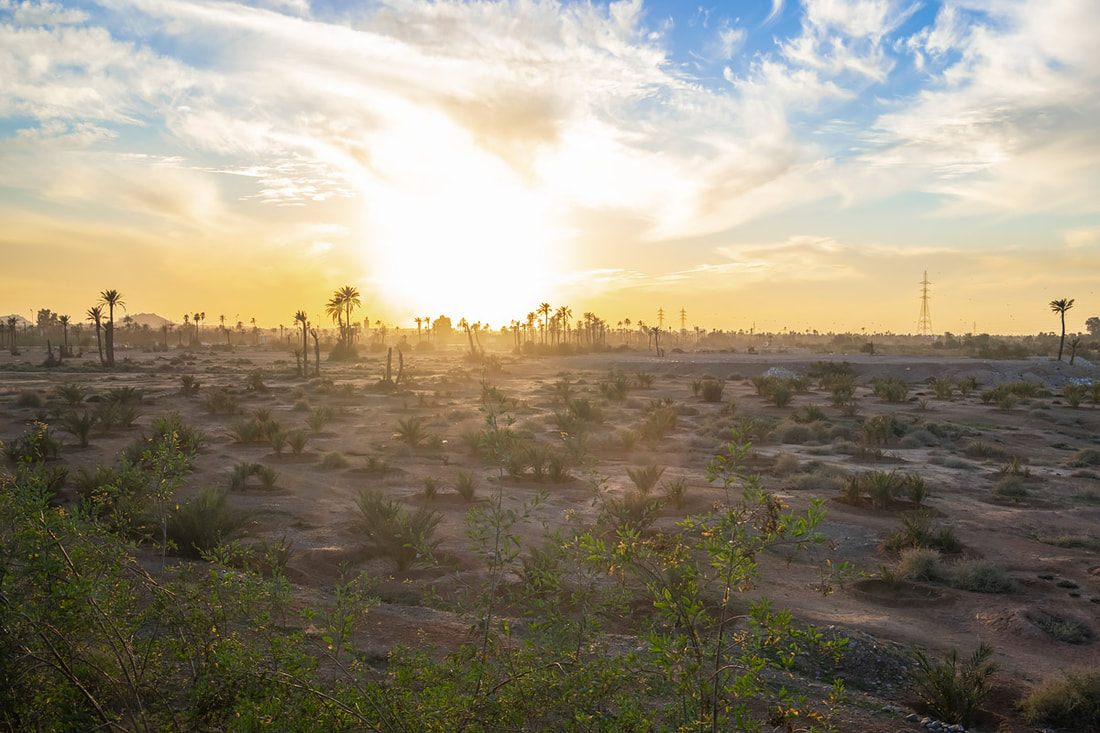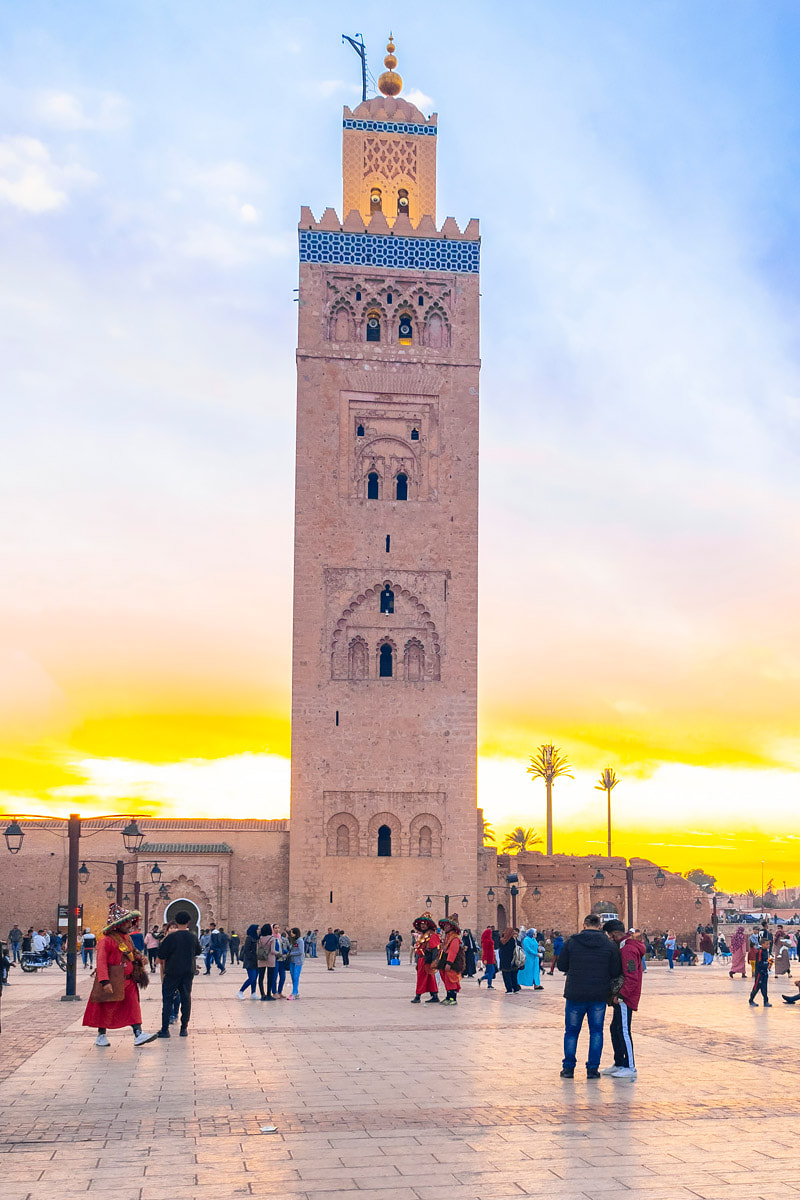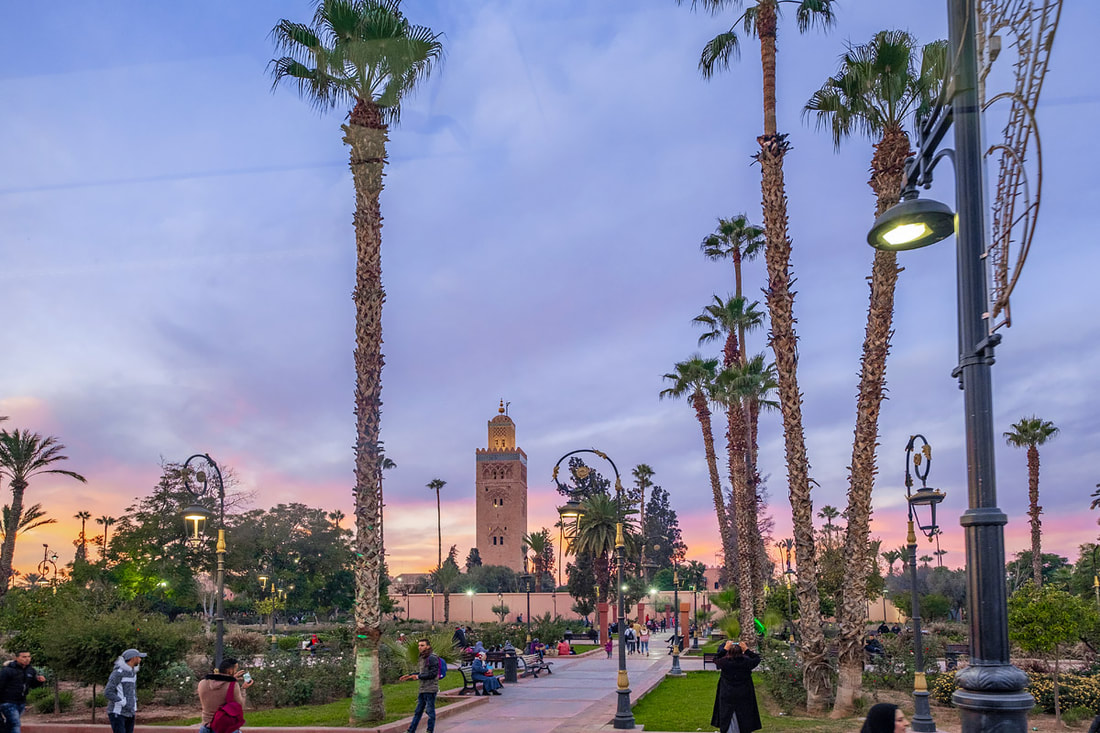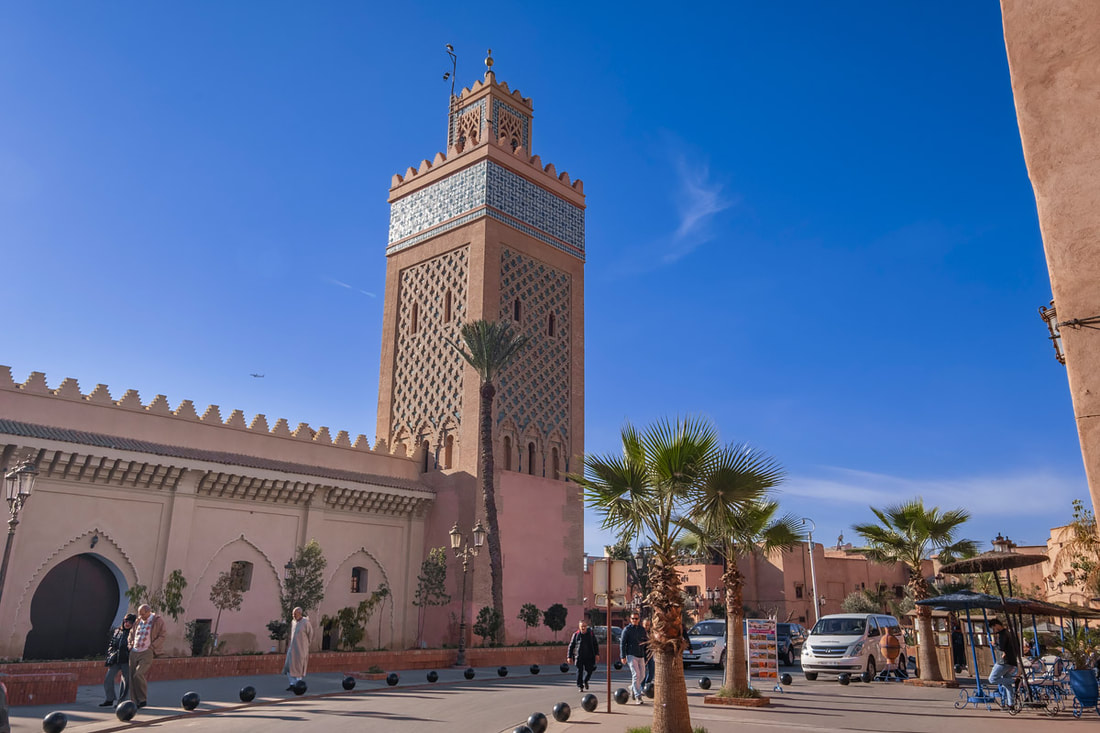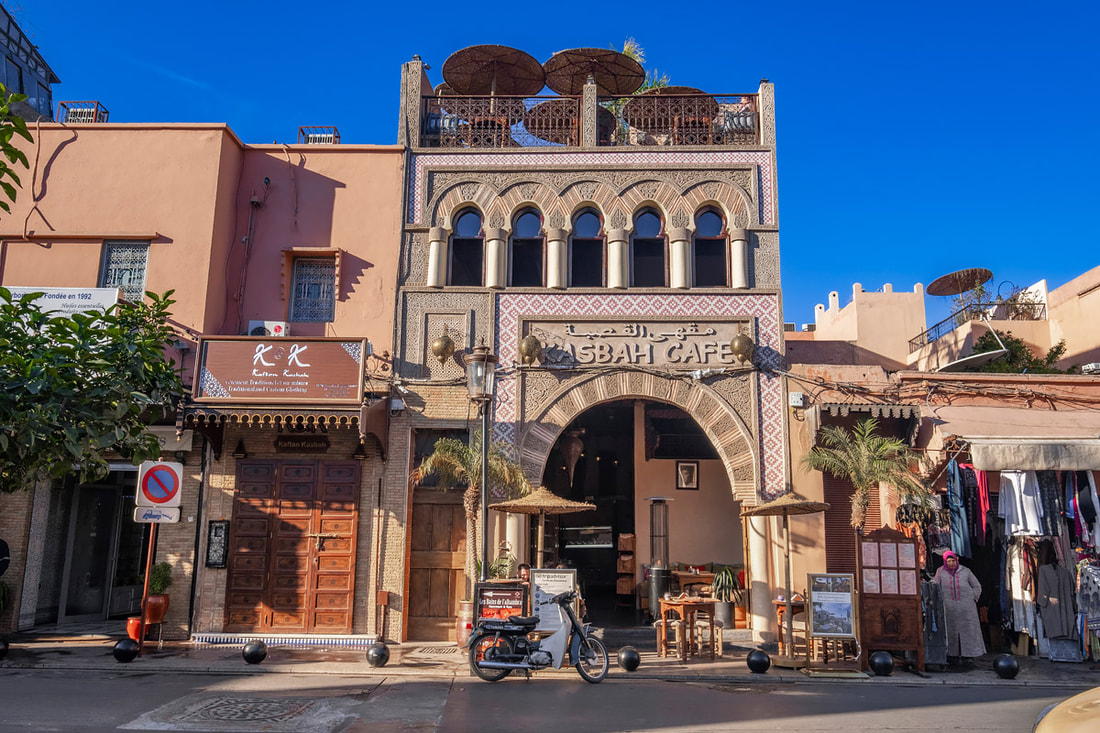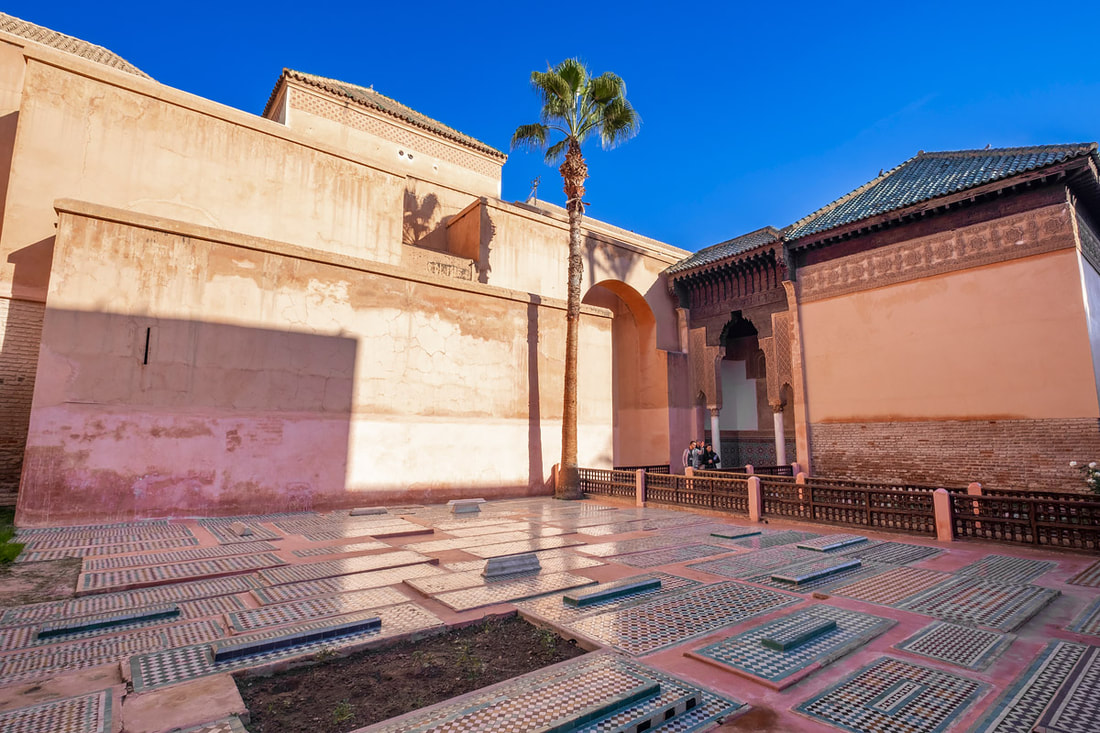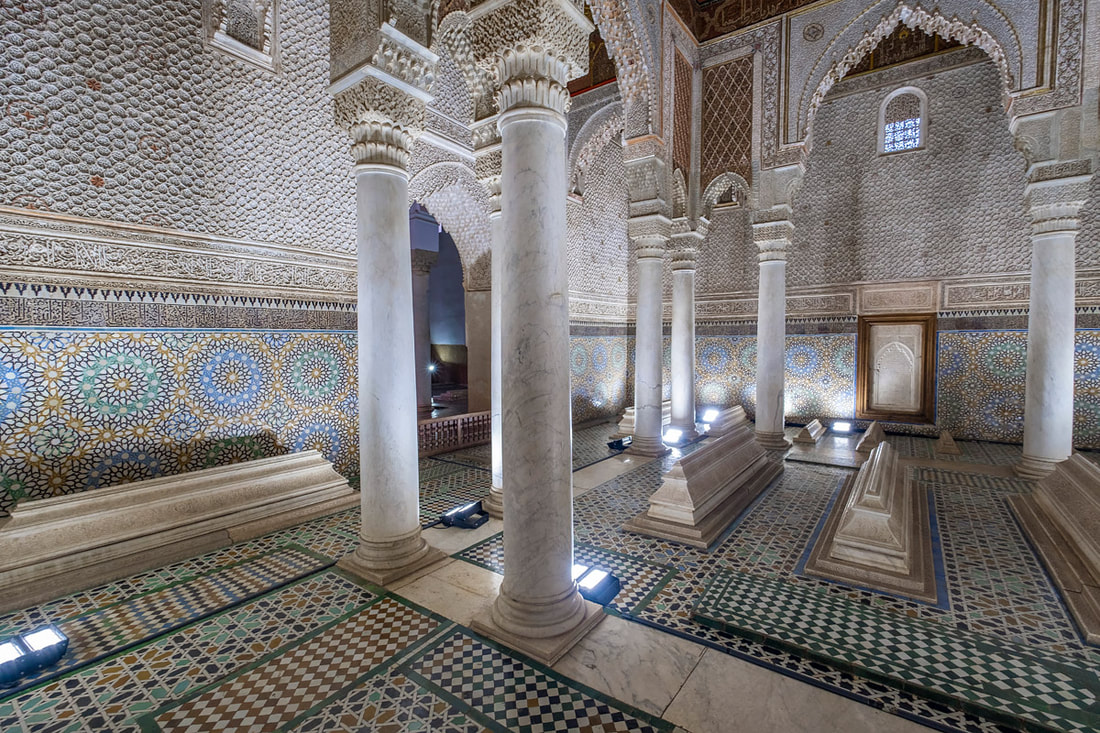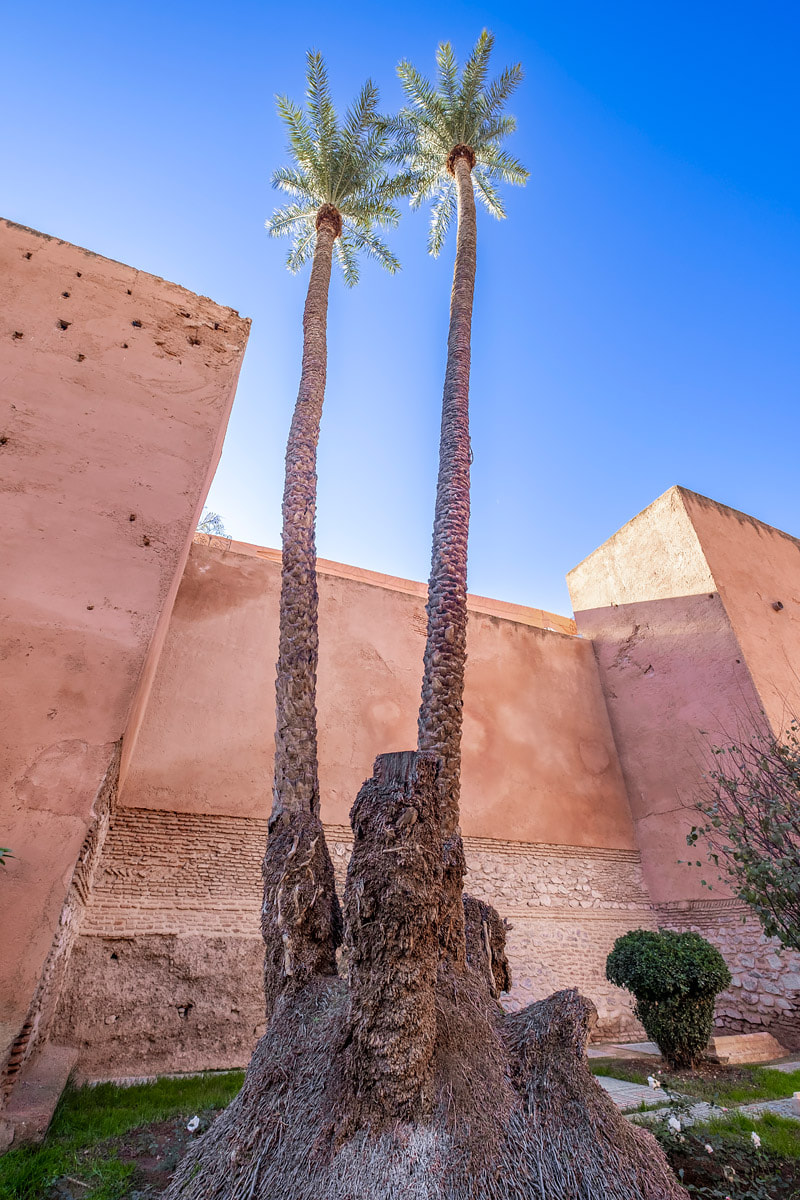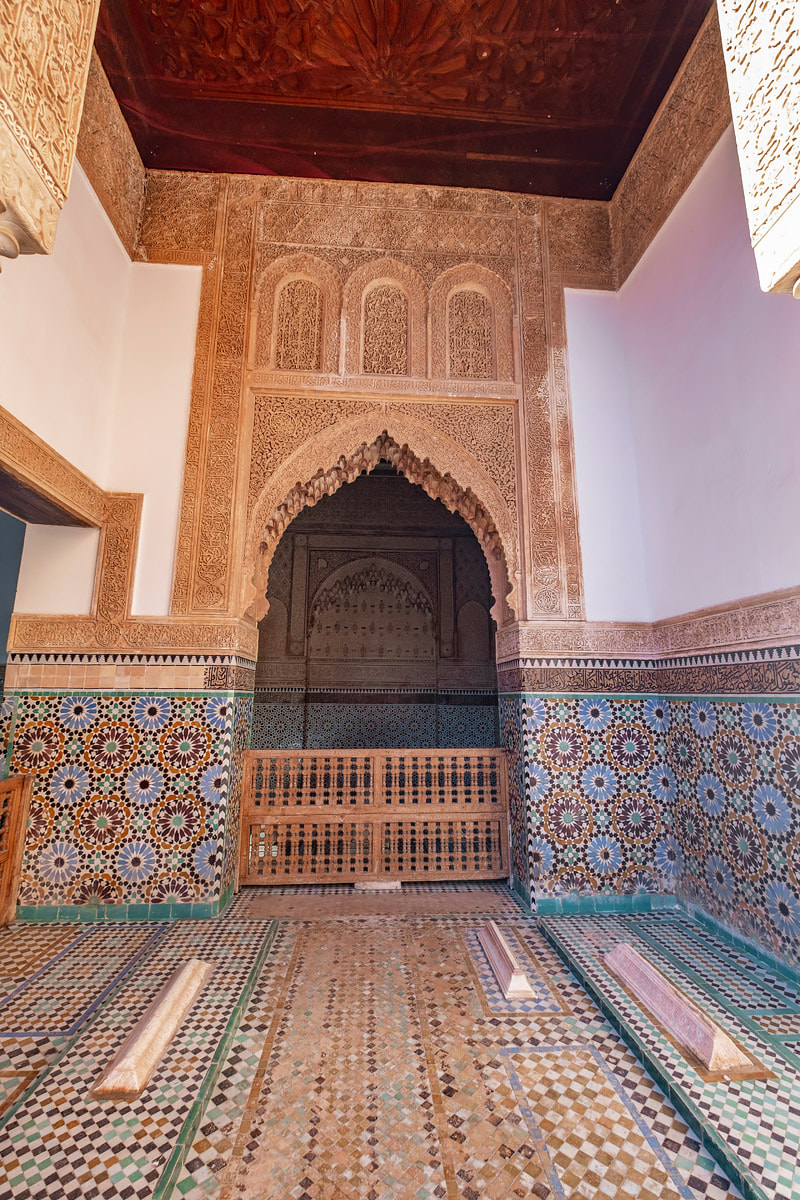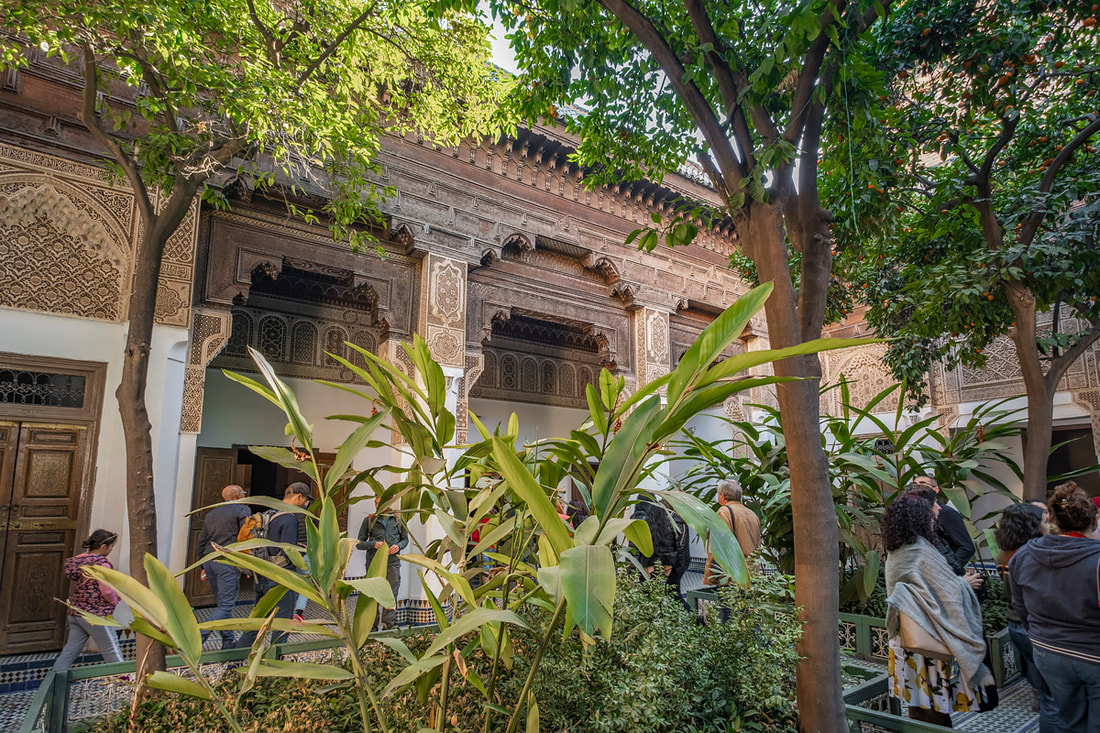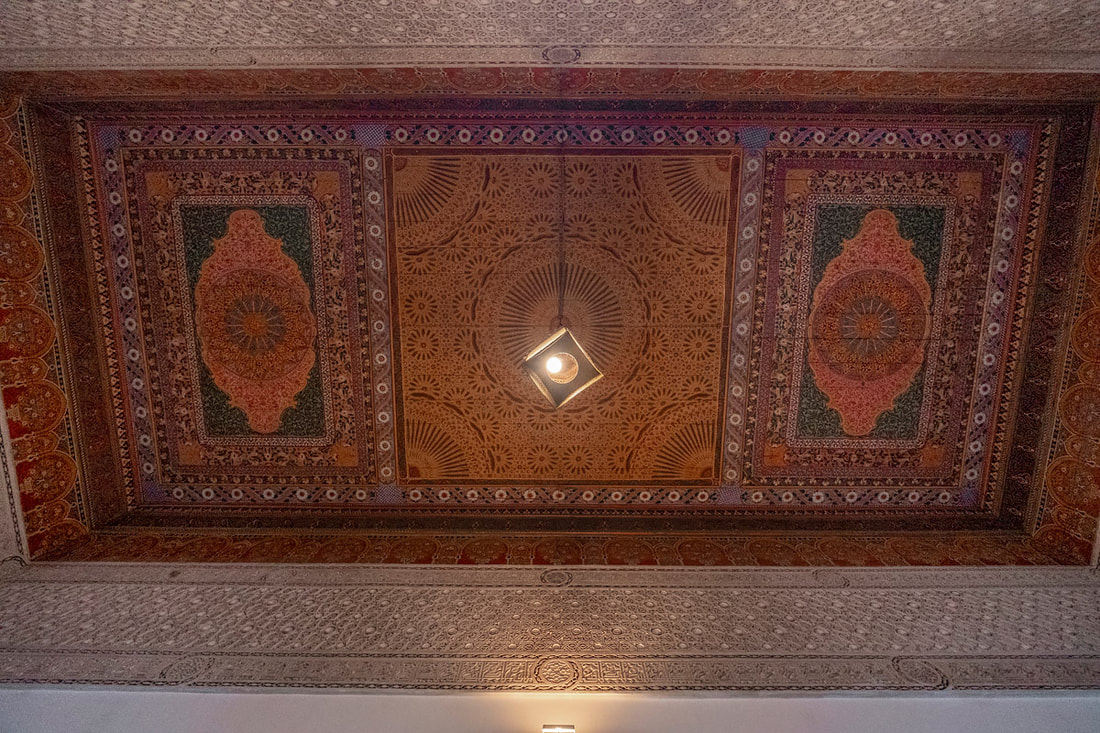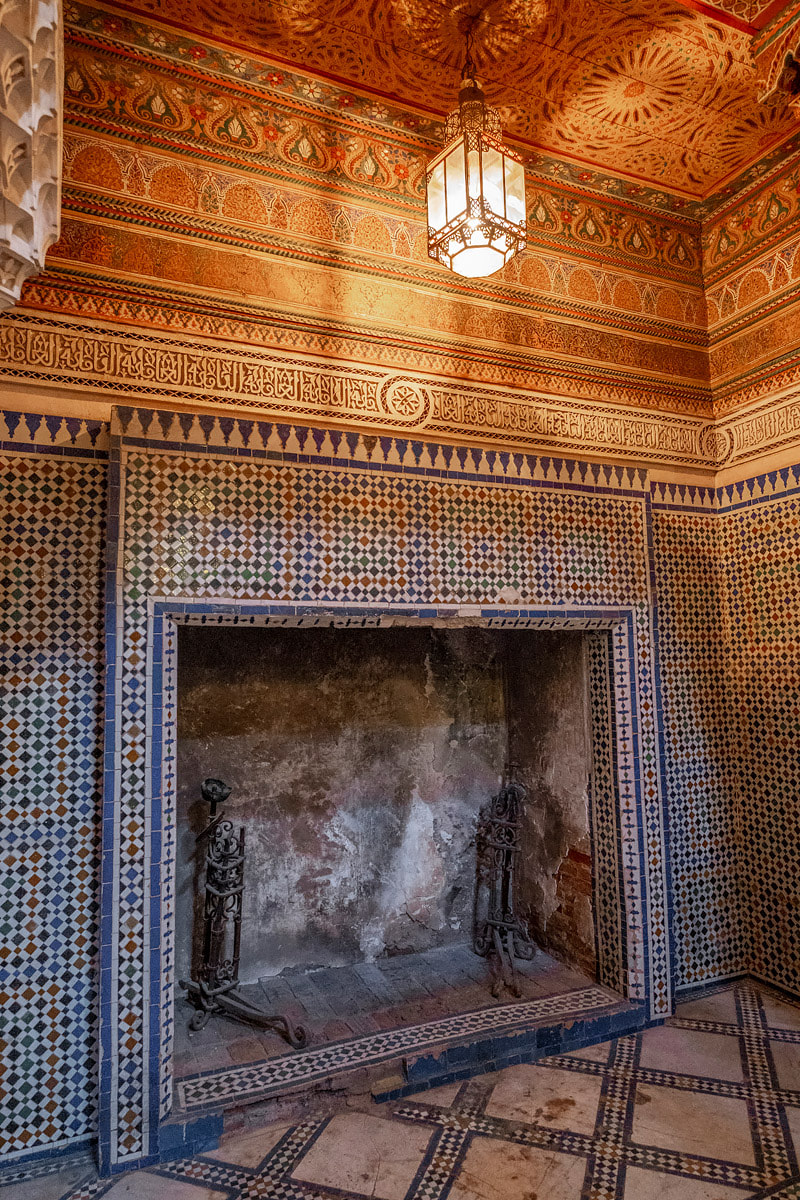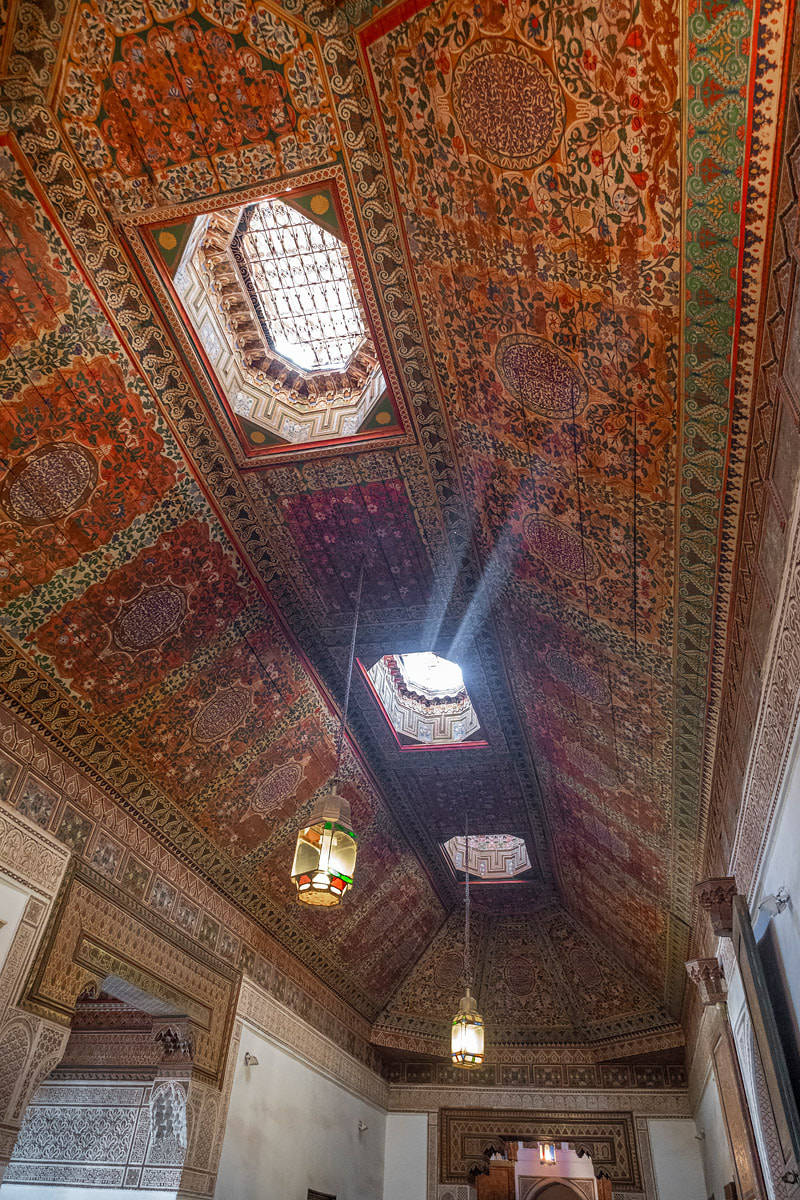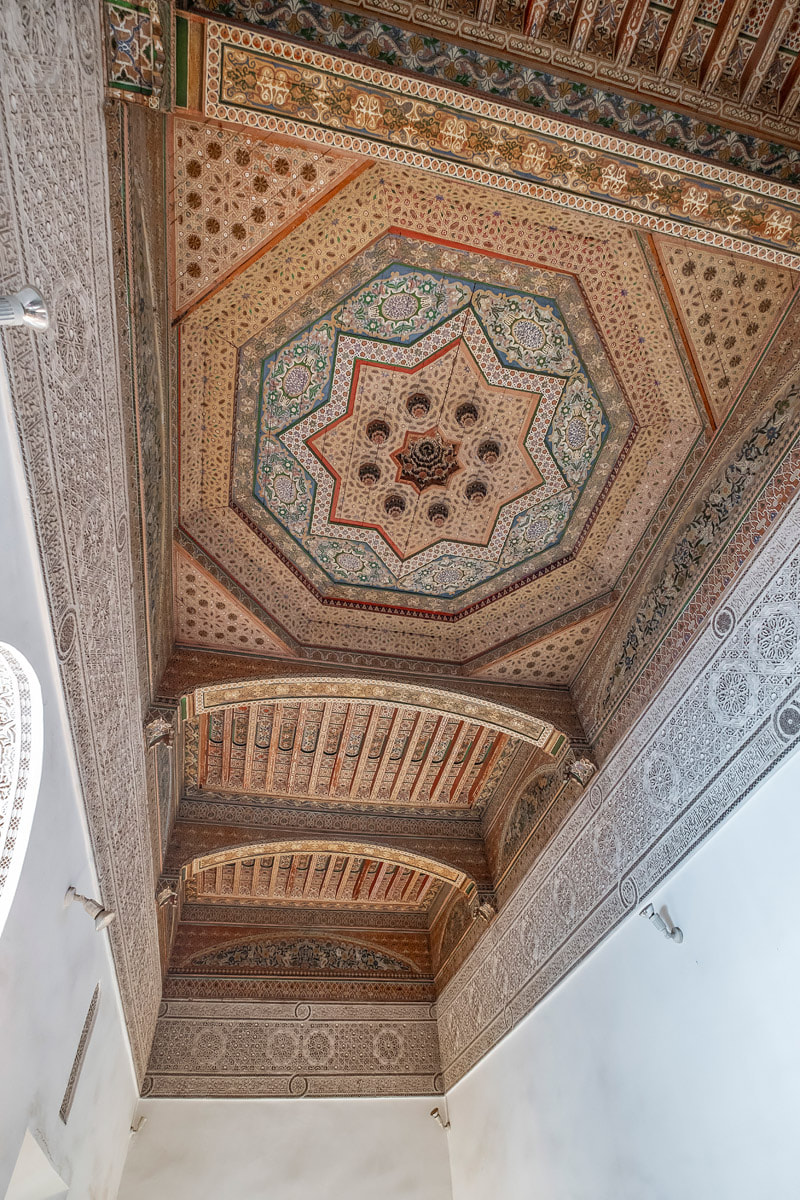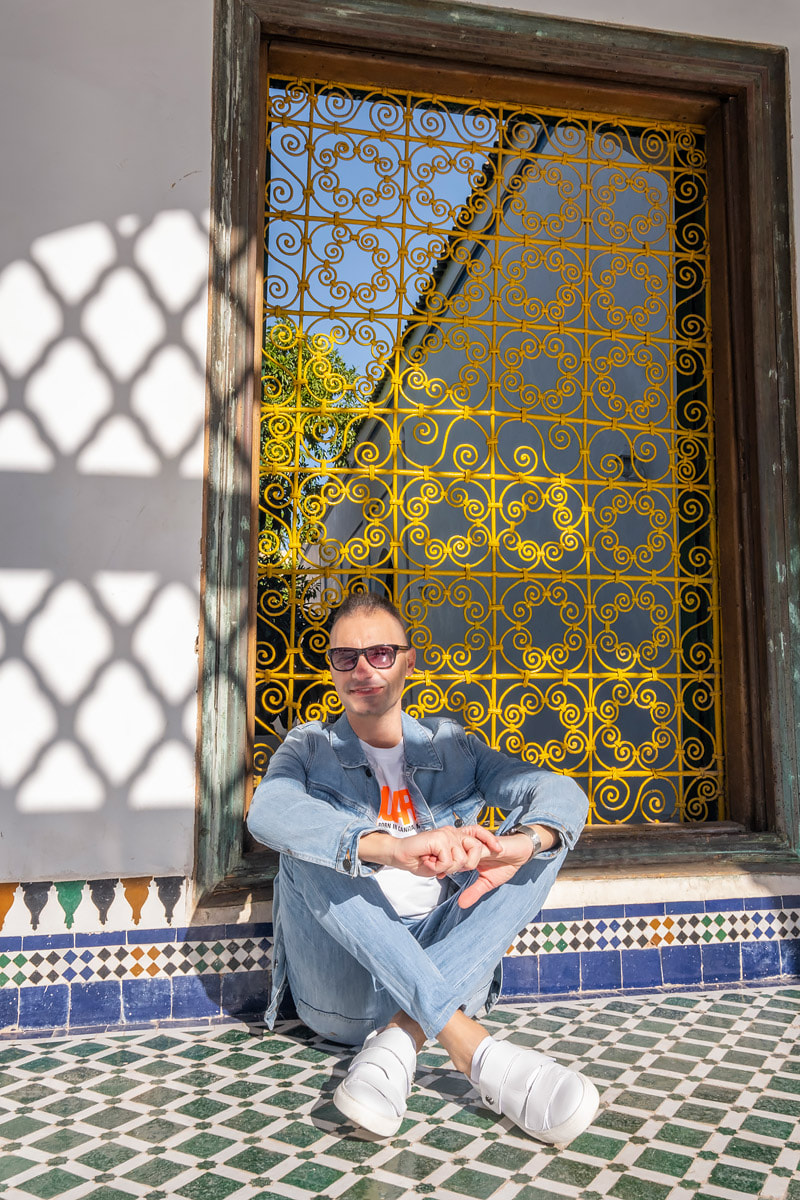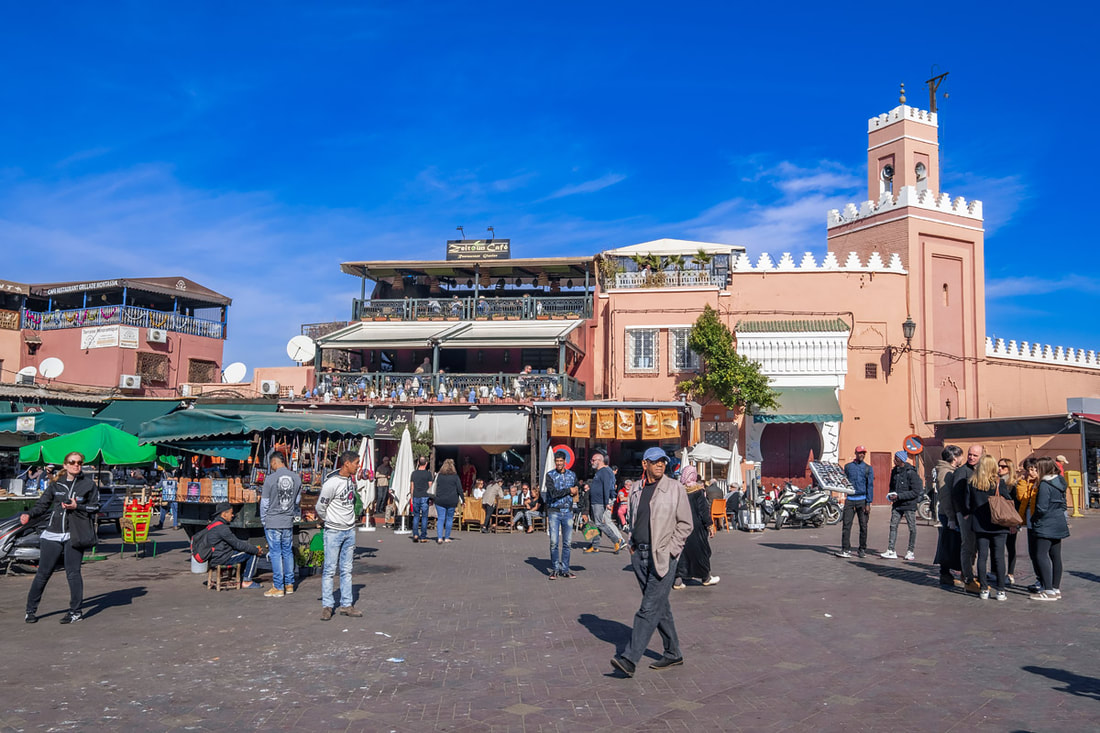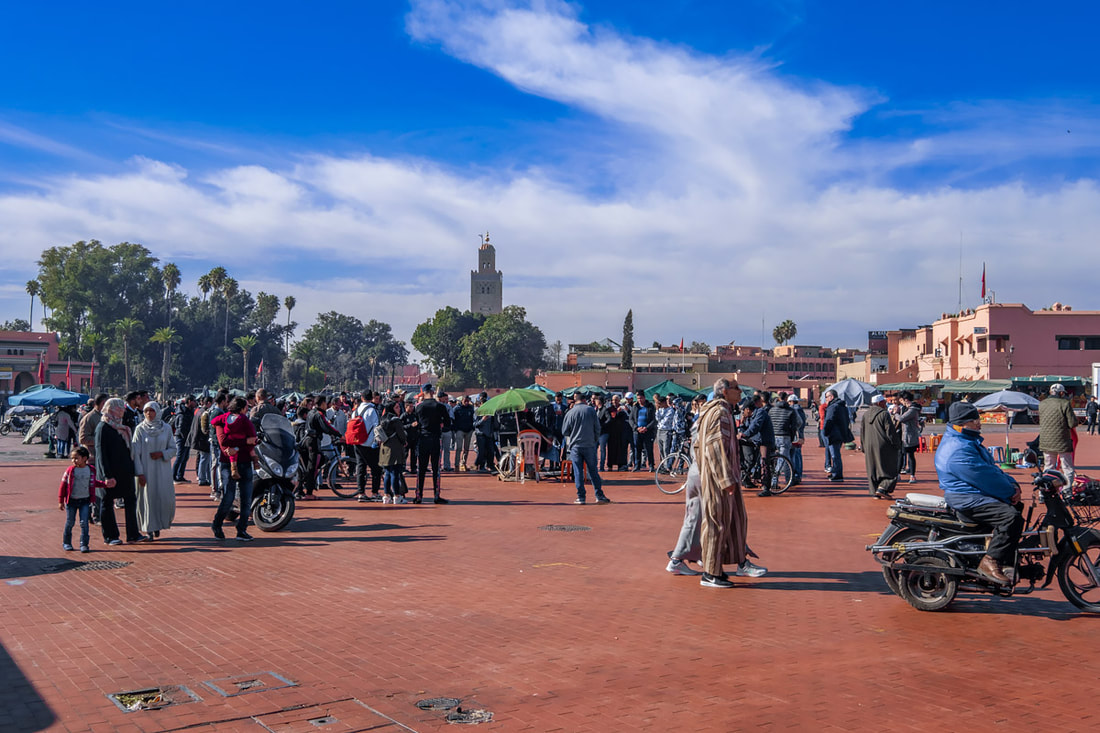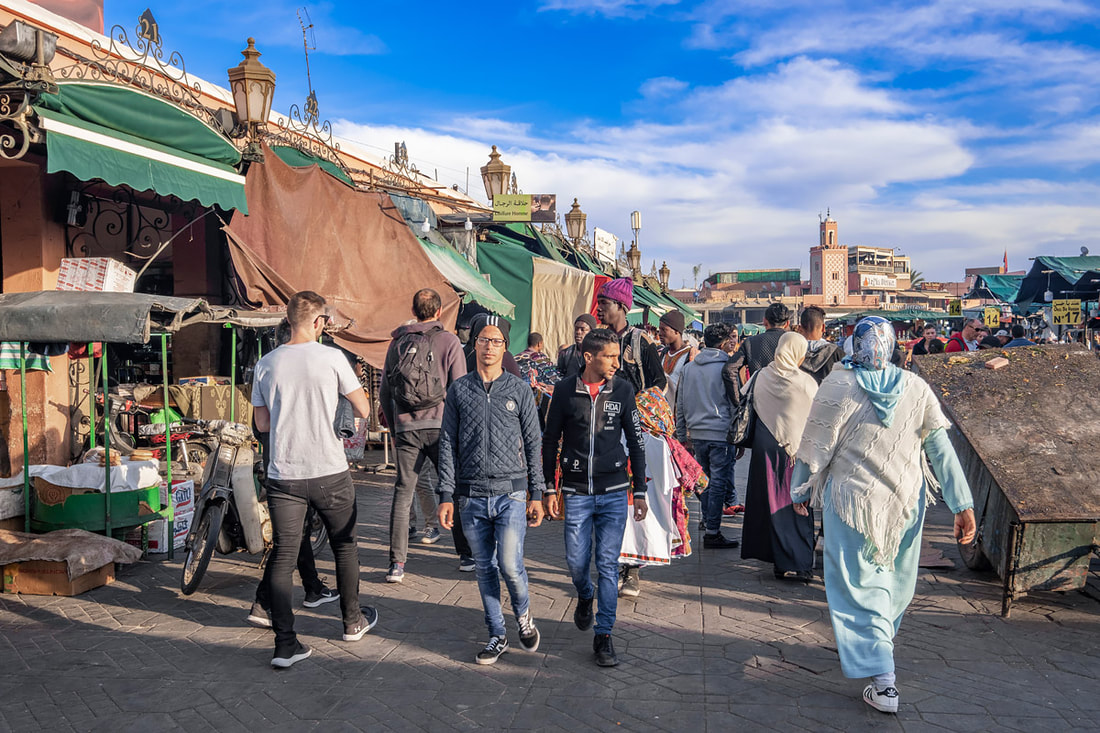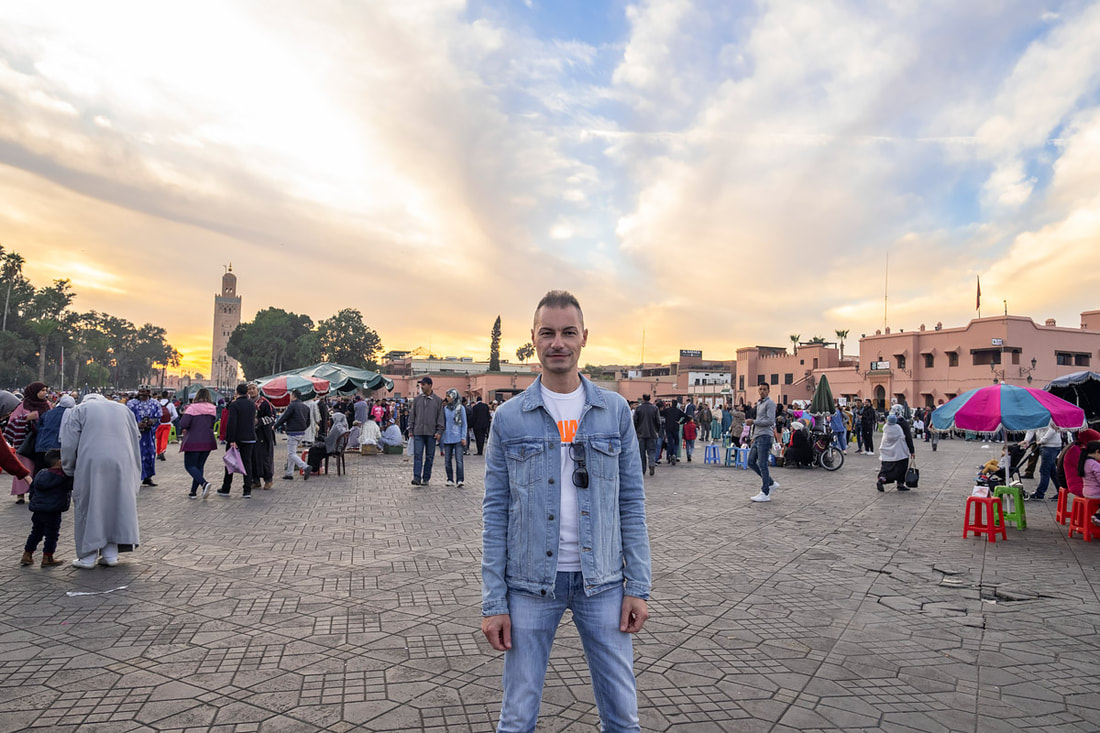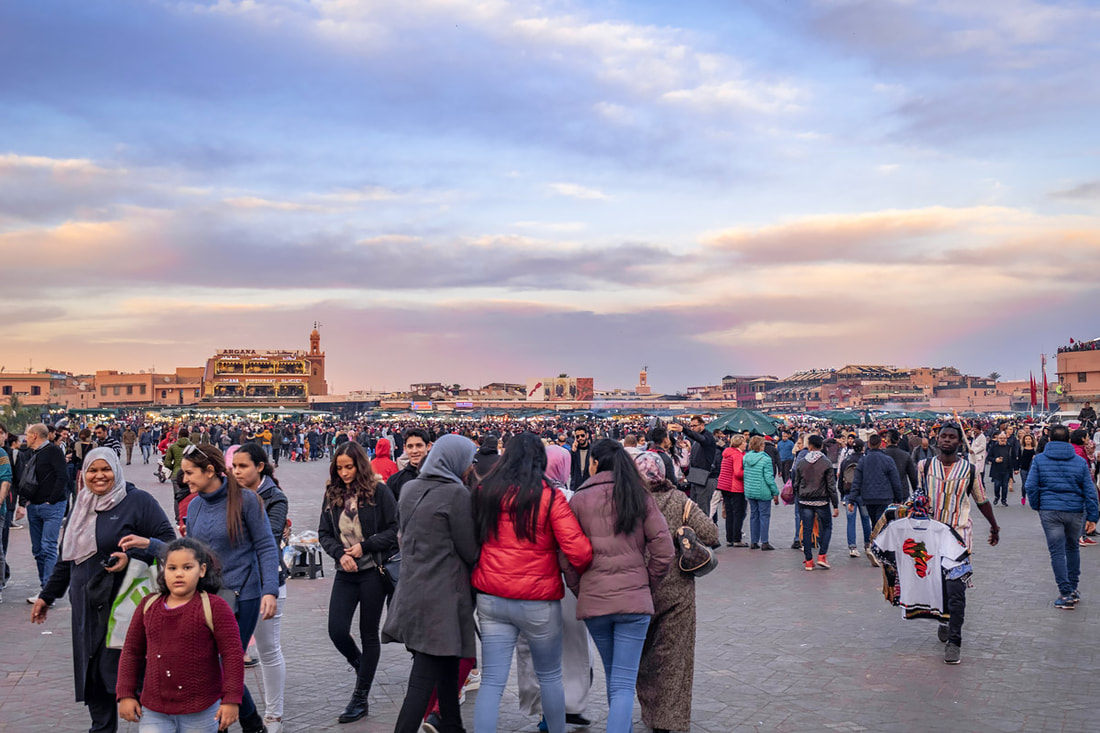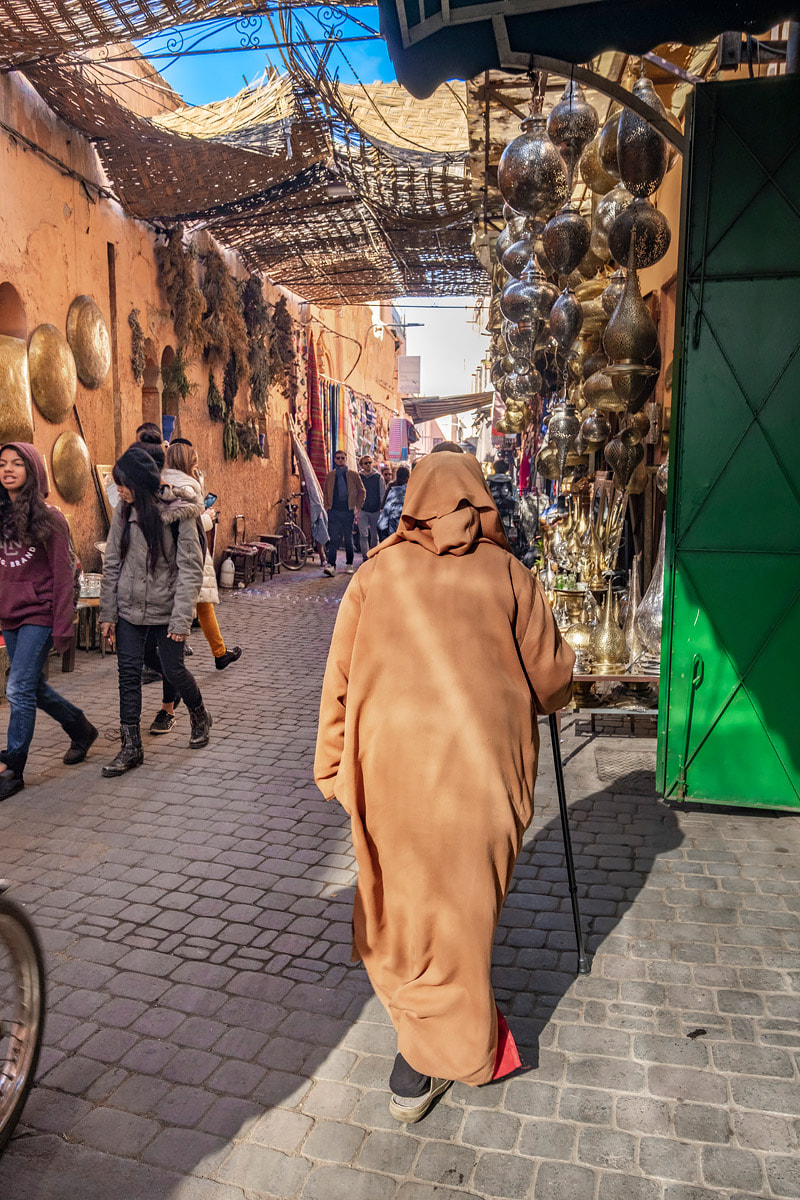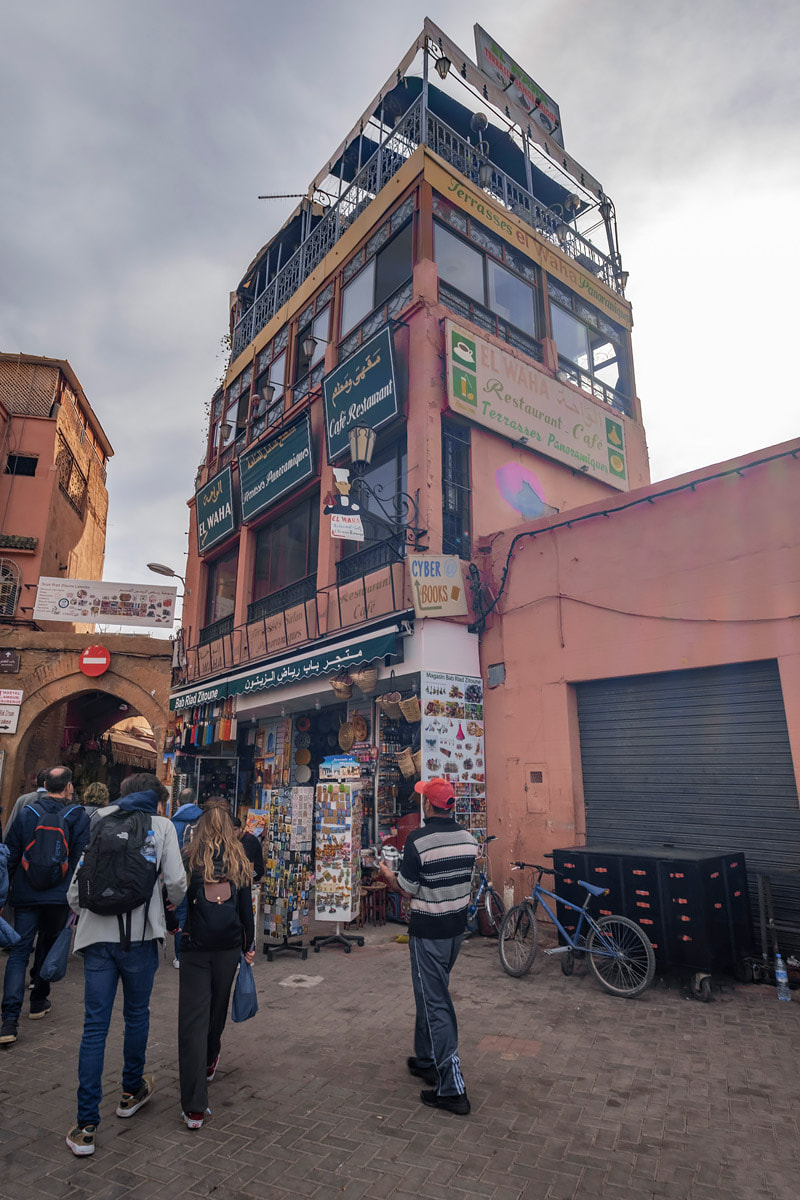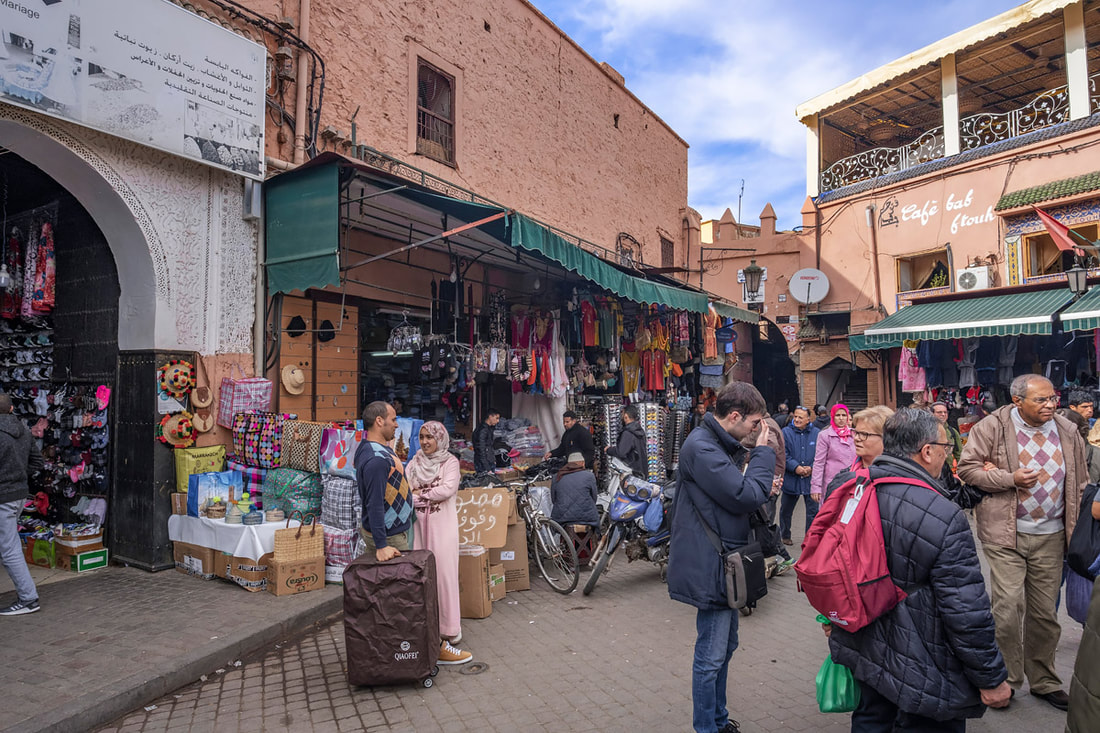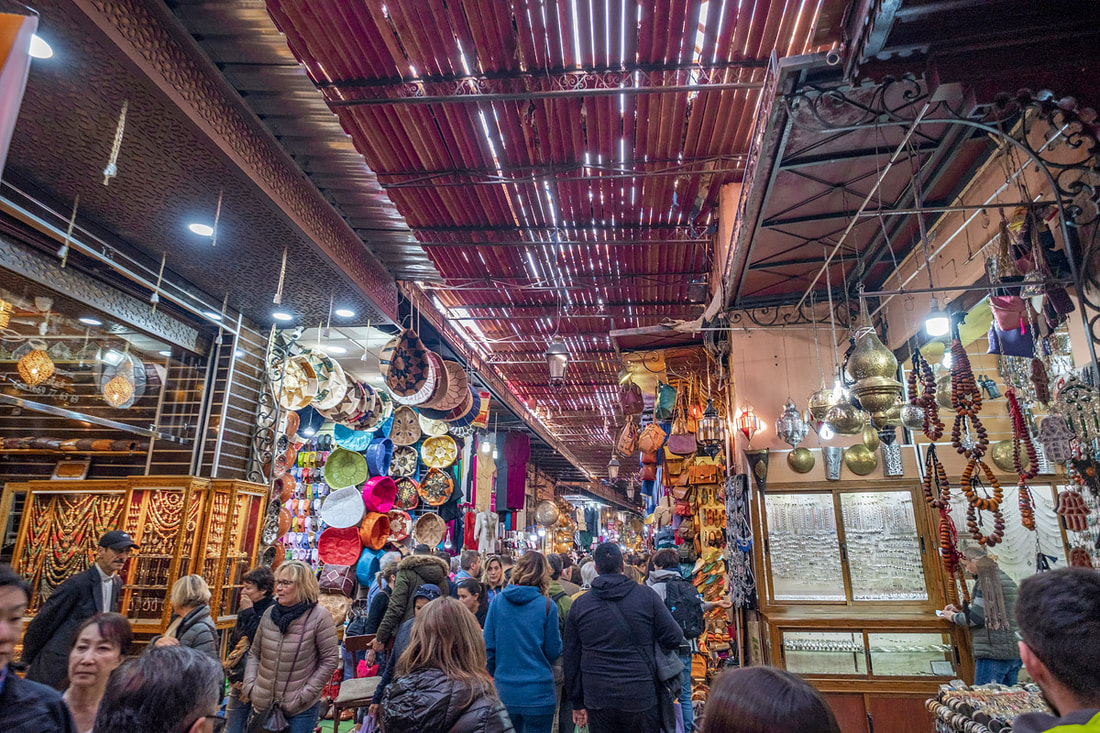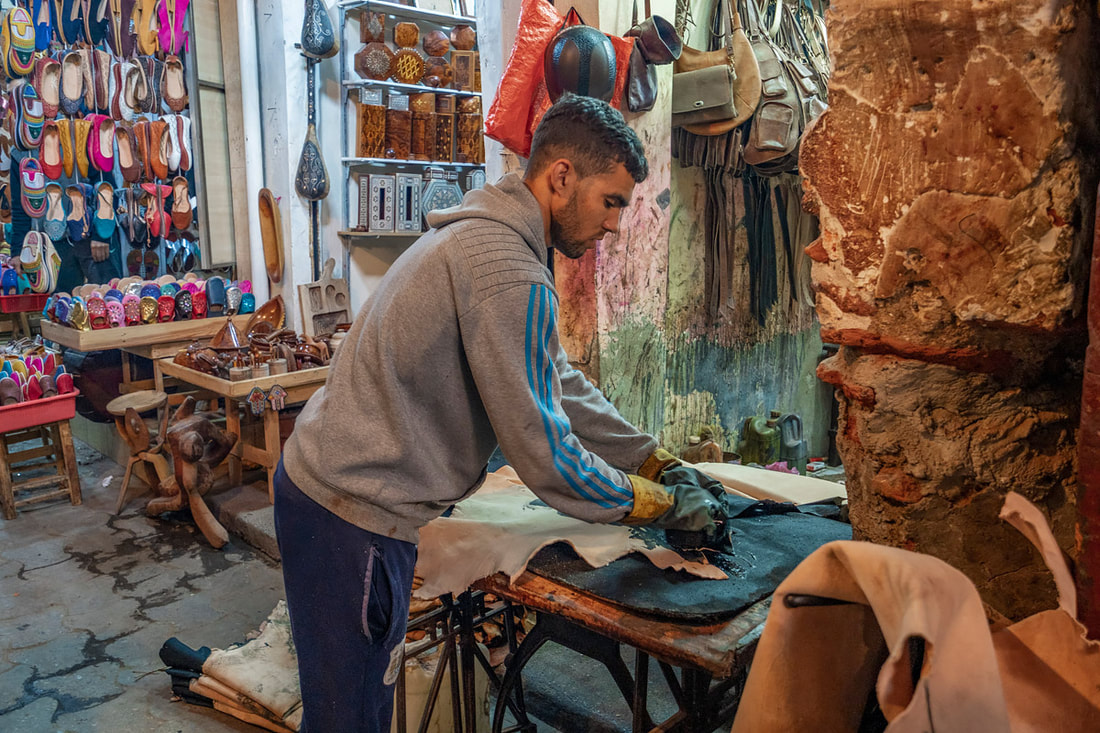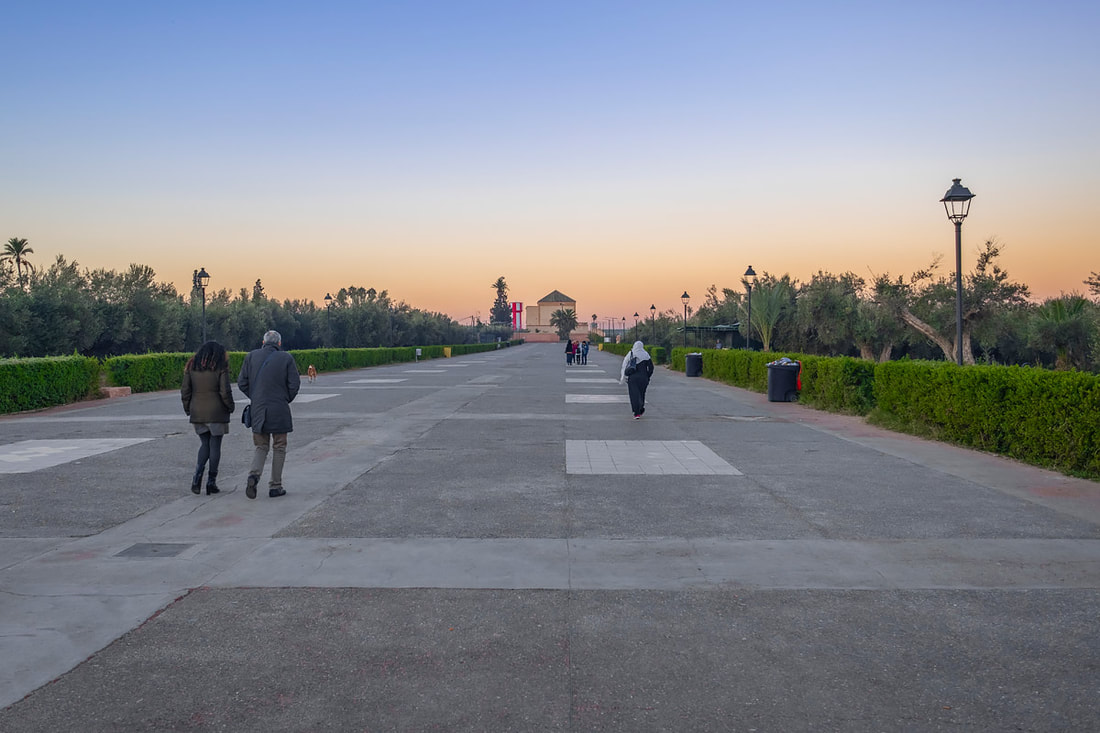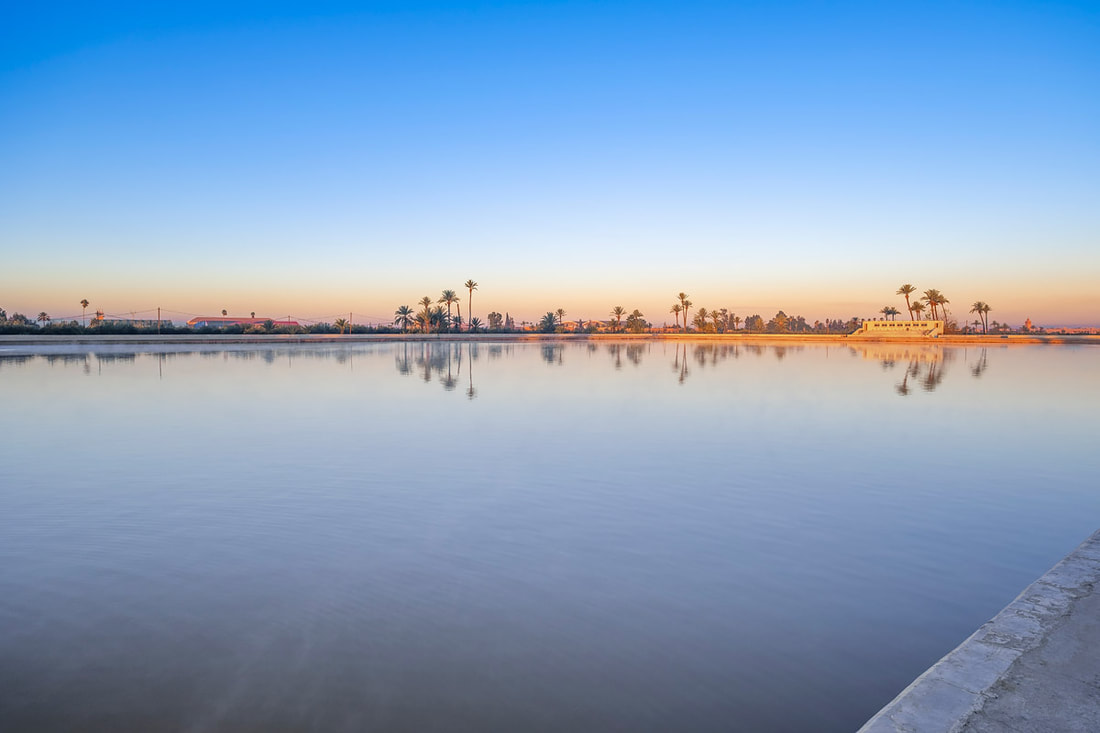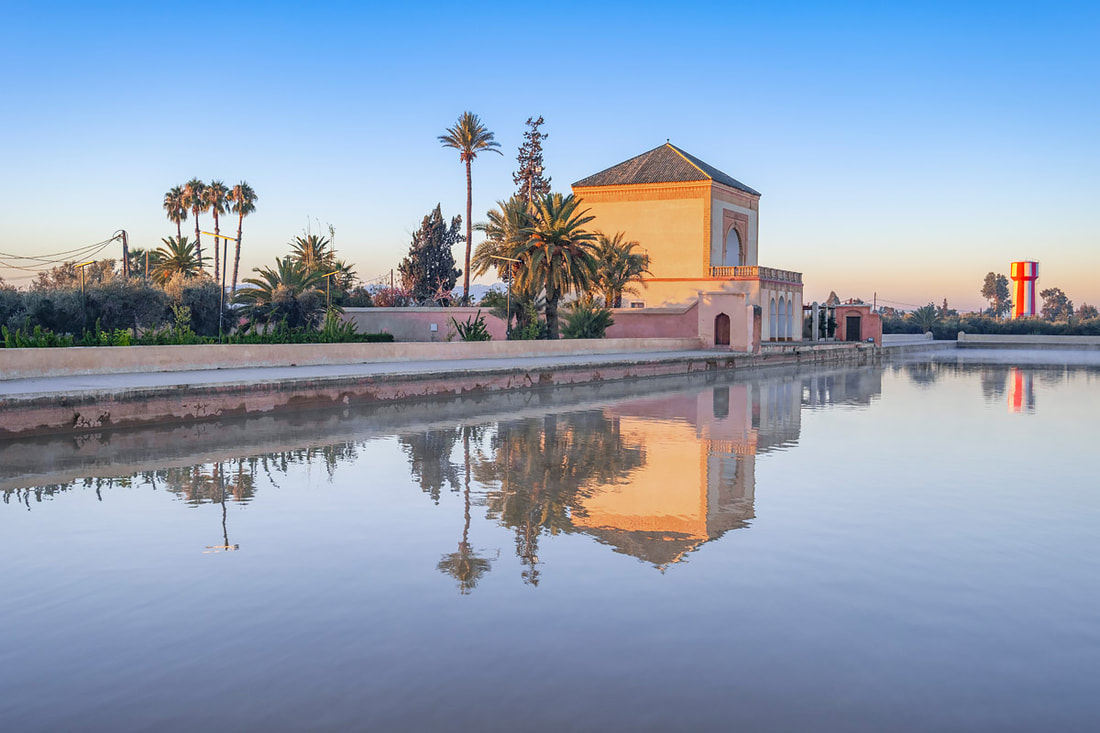By Antonio MalaraMarrakech was the second destination I visited in Morocco during the trip made with my sister and a group during the New Year's Eve 2018. In the Casablanca post I wrote about how the idea of the trip was born that led us to visit the major cities of Morocco. Marrakech was certainly the most popular and most important of the destinations, or at least this was the general feeling of the group, also influenced by the explanations of our guide. Personally I had the same perception, I had studied Morocco in general before leaving and certainly Marrakech was a bit of a symbol of it. My first approach to the city was more than twenty years ago thanks to Alfred Hitchcock's film "The man who knew too much", the second version with James Stewart and Doris Day. That film full of mystery opened right in the Moroccan city, with the protagonists immersed in the chaotic but colorful and vibrant Marrakech. I must say that I have always liked that Arab style of which in a certain sense I’m a descendant and I have always found a kind of order in that confusion of markets and vendors shouting to sell their wares. This cliché, over time, led me to give names to the things I had seen in the film and that struck me about the city. So before leaving my attentions were mainly on "Jamaa el Fna" square, the Medina and the "Kutoubia Mosque", mainly its minaret which together with “Jamaa el Fna” identified the city of Marrakech in the photos. Unfortunately in recent years there was another source of "information" which were the social networks where famous people and pseudo-such, had themselves photographed inside the luxurious hotel "La Mamounia". The spaces inside this hotel were certainly beautiful and mesmerized with incredible decoration and details, however whenever I researched Marrakesh using social media, it annoyed me to see only pictures of the hotel. In other words, the rich and the first wave of influencers had increased the popularity of the city by managing to publish only photos of themselves inside “La Mamounia”. Their idea of the city was probably limited to that luxury and they certainly hadn't bothered to mingle in the true soul of the city which was the Medina, where there were unknown people who touched you and spoke to you a few centimeters from your face . In other words, the true charm and tradition not only of the city but of an entire culture. Fortunately there had been people like Yves Saint-Laurent who had discovered the city in unsuspecting times, finding in Marrakesh an ideal place, with a philosophy opposed to the stressful life of western capitalist "culture". Unfortunately today the real artists have given way to the untalented people, who are popular just for being popular. Luckily for me, however, I discovered that Marrakech was much more than what the boring rich showed, my archetypes, combined with the research and information of our guide, made me discover a city of infinite nuances, which as always when it comes of places never seen before, it is always better to discover than to study. We arrived in Marrakech at around 6:30 PM after a long journey from Casablanca, it was December 31st and we were going to celebrate New Year’s Eve in this exclusive city. The panorama before arriving in the city was singular because it was deserted but full of palm trees, an original context. At the gates of the city, literally because Marrakesh still had a wall which, even if low and not imposing, gave the sense of the city which is accessed through the gates which in this case had an arched architecture. The impact with the disorder of the city was like a liberation for me. In fact, in Marrakech, a bit like I wrote in the Amman post, there weren't those "democratic" rules that require you to do things without giving you a choice. In the city it was full of people on bikes who drove without helmets or with three passengers. Road traffic in some parts of the old city was not regulated by traffic lights and was therefore more fluid. That orderly chaos which then was that of my city until the 90s is what I miss the most, a civilization disguised as disorder which however works better than the draconian rules of today's "democracy". Our hotel was a few kilometers outside the city, a good location anyway because of its new design and also served by various activities. That evening there was a New Year's Eve dinner after which there would be music and celebrations throughout the night. The dinner was very pleasant together with our group and also with the other guests of the hotel, however after midnight we were only a few, both because there the music for the celebrations was of a different rhythm, and because the day after we had appointment at 9:30 AM. In general, I spent a pleasant night and to tell the truth, there were also some opportunities for some adventures which, however, I wanted to avoid so as not to start exploring the city without sleeping. KoutoubiaThe first monument we visited in Marrakech was also the most important of all and paradoxically it was the shortest visit we made in the city. That morning the bus left us at a corner of the "Parc Lalla Hasna", a very large park, full of trees and plants. Right in the center of the park a large sidewalk was crossed in the center by an artificial waterway, the road led straight to the Koutoubia Mosque where its orange minaret stood out beautiful and imposing at the end of the park. We walked for about ten minutes before arriving at the Mosque, with the minaret getting bigger and bigger. We arrived behind the Mosque, in fact the minaret was at the opposite end from us. A negative thing that I immediately noticed was a photographic aspect. Unfortunately at that time of the morning the whole structure was backlit so the colors could not be appreciated well and also from a photographic point of view it was very technical to photograph the Mosque. Our guide gave us a short lesson on Koutoubia; it was the most important religious site in Marrakech and although the Mosque was not the largest, it was still a very important structure. It had been built in the year 1.110 in an Almohad Islamic style, inside there was room for up to twenty thousand people who could pray at the same time. The minaret had a square plan and was 69 meters high and featured many decorations especially in the upper parts. However, the thing that immediately struck me about our guide's speech was when he said that the minaret tower had two other twins: one was the Hassan II Tower which was in Rabat and we would visit it, the other was the Giralda which was in Seville in Spain. That detail stuck in my head and never went away. Seville was a place I had always wanted to visit and that detail gave me the determination that led me to make that wish come true that same year. From an aesthetic point of view, the Koutoubia was very wide but the structure was low, it gave the sensation of a rough architecture and the base was a continuous arches around the perimeter. As for the minaret, it could be seen from many places in the center of Marrakech and was in a sense the symbol of the city. Aesthetically for me it was beautiful but I love towers in general so my opinion and my enthusiasm are always conditioned by my preference. As I said the Koutoubia could be seen from different angles of the center and it was always a magical, exotic and mysterious experience. A different symbol than the ones I was used to seeing in my places but every time I saw the Koutoubia I always had the impression of something that was close to me, that belonged to me. A strange experience such as memories of a previous life or that of a dream. During our days in Marrakech we saw the Koutoubia many times and when I could, I preferred to go a longer way but always pass by the Mosque with its timeless charm. Saadian Tombs The Saadian Tombs were the second place we visited in Marrakech. We got there after a very short bus ride from nearby Koutoubia. The driver left us right in front of the "Gate of Bab Agnaou", an ancient and large entrance gate to the city with arched architecture completely made of red bricks. After crossing it and walking a few steps we found ourselves in front of the “Moulay El Yazid Mosque”. To tell the truth, that area seemed like a world of its own because it was a very well-kept part of the city. The mosque was a smaller version of the Koutoubia and all around there were places like restaurants and shops with an Arab style but recently built. What I immediately noticed was the handcrafted attention to detail of those places; for example seats and tables of some cafes were completely in wood and handcrafted as well as some furniture. It was a sign of distinction in an era where especially furniture is all the same because they are globalized in the popular all-white modern designs made of strange plastics. The Saadian Tombs were right next to the mosque and we entered with the group after a short queue. As usual, I tried to listen to the guide but focusing above all on photography. The Tombs were a mausoleum of the Sadian dynasty and one of the most visited places in Marrakech. The reason was evident and could be perceived immediately upon entry. The tombs were a large internal courtyard surrounded by pink structures and towering palm trees. Some tombs were outdoors enclosed by wooden fences and decorated in ceramics. Other tombs were within the various structures and while retaining the same style for the tombs themselves, it was the structures that were architectural and decorative masterpieces. There were only a few small spaces from where, following a row, one could glance inside and quickly admire both the structure with marble columns and the ceramic decorations. Overall the whole place was kept in very good condition and some of the structures had superb architecture even from the outside with large ornate arched doorways. Both the paths and the plants outside were so beautiful and original that they greatly inspired my photography, even let's say posed. In fact, with all due respect to a sacred place, it was also nice to pose for photos because the whole area was harmonious, with a light appearance and not serious or sinister like a normal cemetery. The most original thing we saw and that I used as a location for the photos was a small ravine, all decorated and with a protruding wooden roof, I don't know what it was but I hope I haven't broken someone's memory. The visit to the Saadian Tombs was a short experience of only half an hour but very relaxing from an aesthetic point of view and rich from a cultural one. A proof of the beauty of a people who celebrated death, leaving an example of aesthetics even in earthly life. El Bahia PalaceThe visit to El Bahia Palace was one of those things that took me by surprise. The frenzy of taking pictures and transferring them to my phone and then sharing them didn't make me feel in any way the place I was going to visit. This is something I no longer do and above all a practice which, especially on travels where there are short journeys, diverts attention from very interesting things that can be noticed while traveling by bus. The fact is that I found myself together with the group in a place without knowing what it was and as usual I had to be able to listen to the guide and try to capture as many things as possible through photos. The El Bahia palace was built in the mid-nineteenth century and was expanded over time until it became a large and articulated private residence. I don't remember which entrance we used or if there was more than one but the fact is that I found myself together with the group inside a cloister. In reality the place was different and a little smaller than those that can be seen in convents. This had a real garden with tall plants in the center while the covered part had typical arabesque decorations but also wood and marble. The place was made up of many rooms, all very large and the communicating doors had the typical arched style. Surely in addition to the marble flooring made up of many small elements, the surprising thing was the decorations on the ceilings! Some had an octagonal plan while others were rectangular but the quantity of decorations and details was incredible, as well as the visual impact which in a certain way was amplified by the fact that the rooms were completely empty and without furniture. The decorations did not follow logic but could be found almost everywhere: in some rooms they were on the walls, other times they could be found under the arches of the doors or even under the arches placed on the ceiling. It was like a style that wasn't a style in the sense that each room had its own personality, both in terms of colors and decorations. After about twenty minutes of going through one room and another, we went out and found ourselves in a quite ordinary place but with a unique beauty. It was the courtyard of the building, a rectangular wooden portico followed the entire perimeter of the courtyard. There was a fountain in the center in the middle of a totally marble flooring but what gave value to the place were the colors. Blue, yellow and white of the portico together with the green of the roof of the structure and the various white and green designs of the flooring. In addition to this, as a background there were tall palm trees that were beyond the courtyard but made a very exotic setting. That place for some reason immediately put an incredible calm in me, I was more in harmony there than inside the rooms. The courtyard was like one of those eccentric Hollywood mansions that extend only to the ground floor. I don't know if the place had hidden energies but surely something had an effect on me because I didn't want to leave the courtyard. My sister and I took many photos, certainly more in the courtyard than inside the rooms. The courtyard led to other rooms which then led to the exit. The peculiarity in one of the last rooms were the stained glass windows that projected the colored drawings onto the wall, like a sort of magic of timeless places. El Bahia Palace is another example of how one should and shouldn't visit a place. On the one hand, knowing nothing I had the surprise effect, on the other if I had known a little history I could have concentrated on better documenting a few more details. Jamaa el FnaJamaa el Fna square can undoubtedly be considered as the vital center of Marrakech, the reference and identification point of the city. Precisely because of this characteristic, this square with an irregular shape has been for me and the group, the expression of our individual independence. The first time we went with the guide, who after explaining various details to us, also taught us how to get around and what to use as a reference so as not to get lost. This was because in Marrakech we also had free time to wander around on our own and Jamaa el Fna square was the main place where we would be moving around. To the north of the square began the Souk but I will speak about this part later, while to the west, a long road led to the Koutoubia. The square was surrounded by commercial activities such as cafes and restaurants and during the day there were street vendors close to them. The view during the day was a bit dispersive and did not look like what I had seen in photos. The first time I got there, I didn't understand why the square in the center was practically empty. There were groups of people or tourists gathered and then many vendors covered by their umbrellas selling their wares. But after a short time I understood why Jamaa el Fna was magical, I think we were returning from the Souk around 5 PM and arrived at the square, I had some doubts that it was the same as in the morning. What I saw were several stands with umbrellas that were much larger and arranged in a certain order than those of the sellers seen in the morning. My impression was that those stands were more oriented towards the sale of typical products as well as those dedicated to street food. Besides there was an infinite number of extra people, the combination of these factors had been enough to change the look of the square, in other words they gave a specific and geometric dimension to what was just an open space. I noticed that the more evening it got, the more the square filled up, in the sense that I had the perception that everything that was there, not just the people, began to take on a wider shape. At first I thought it was just a perception given by people but later I understood why. Just before sunset, Jamaa El Fna gave the impression of being one of those places where an event, such as a concert, would soon take place. The sun was setting and the multiple lights of the square began to spread a different light but always with warm tones. The real surprise of the square was not the afternoon but the night. It was just when the guide took us to visit Jamaa el Fna at night, that I understood the magnificent metamorphosis this square was undergoing every day. Around 10 PM Jamaa el Fna was yet another version compared to the morning and afternoon and the first thing that struck me was not visual but olfactory. There were smells throughout the square that were incredible, smells of cooking food and roasting meat that literally blended and created the aroma of the square. In reality this olfactory aspect had a visual equivalent in the fumes that rose upwards and by identifying their position it was possible to understand where a stand for dining could be found. In fact, the other singular aspect was represented by benches and tables that had been positioned in an exemplary way near the stands where cooking was done. Jamaa el Fna had taken on a three-dimensional and urban aspect because the stands formed real blocks and the distance between them formed the street. Indeed, at night, streets were born in the square where, in order to orient oneself, one had to take the various stands as a reference, which were real open-air restaurants. Compared to the day, the type of people also changed, in fact the night was full of families and going to dinner there in the square was like a tradition. This was an aspect that I really liked because you could breathe the reality and true habits of the locals in every sense. The singular thing was that the guide had warned us about the smells of the night, advising us not to stay near the stands where they cooked if we didn't want to "stink" the next day. Preserving smells is an impossible thing and to tell the truth, although those of the Jamma el Fna at night were very heavy, I would still like to have them on some clothing in order to take an immediate trip to a multidimensional reality like the center of Marrakech. Medina-SoukIn the first Morocco post dedicated to Casablanca I wrote how in that city, we had no experience about the Medina or more commonly called Souk. Our guide had told us that the one in Casablanca was dangerous and too complex to visit and that it was not as popular as a Souk anyway. Finally in Marrakech we had the opportunity to visit the first Souk but once again the guide warned us that the one in Marrakech was not the most characteristic. The Souks were the markets, the part of the city - Medina - where the traders had their shops. My first experience of this kind was at the Grand Bazaar in Istanbul but that, even if it was a very large area, was born as a market. In the Souks and also in Marrakech, the shops were built in what were houses and in the Medina the houses had a very articulated "urban planning". First of all, it wasn't grid-like, the streets were narrow and most of the time they extended over gradients. In short, entering the Souk was equivalent to being fascinated, inebriated and most of the time you got lost in the narrow streets. What didn't make the Souk of Marrakech special were the streets because the main ones were large enough to pass motorcycles and cars which according to our guide did not make them typical. We entered the Souk of Marrakech with this concept in mind and with proper instructions to avoid getting lost and what references we should use. The Souk of Marrakech although not classic was still an electrifying experience. The nice thing was the varieties of stuff displayed in an exemplary way outside the shops. More often than not the goods served as part of the shop decorations, in fact things like carpets that hung from the roof and reached down to the floor were lovely. When I looked at those goods, I wanted to buy them with the whole store as a backdrop. It was difficult for me to focus on one particular item but I loved looking at the shops in the Souk as if in unison. The nice thing was that the colors of the goods jumped out of the darkness created by the shadows. In fact, in some streets, the proximity of the buildings left little room for light, which then magically appeared when it met the first low building. For me, one of the joys of the Marrakech Souk has been going back alone, being able to walk around it without getting lost. To tell the truth, I had even managed to study a route and leave the Souk in another part of the city, an indescribable feeling of independence and freedom especially in places like that. My experience with the Marrakech Souk was positive and if I hadn't seen others I would say that the one in Marrakech was a great one. However during my trip to Morocco I discovered others and above all one that was of a higher level from a poetic point of view. Of course I will talk about my favorite Souk in the next posts but I must say that the Medina of Marrakech was the perfect lesson to blend into a concept of commercial area that is totally different from what westerners know. Menara GardensWe visited the Menara Gardens early in the morning on our last day in Marrakech before continuing our journey through Morocco. It was a rescheduled visit in fact we had to see them during our stay in Marrakech but our guide was creative and loved to change plans to optimize the times. However, the location of the visit made me understand that this would be short and that in any case it was not something amazing. The Menara Gardens were a vast area of almost rectangular vegetation with a sort of artificial lake in the centre. We got there along a long straight paved road and actually reached the lake. That morning just before dusk, the place gave us a particular atmosphere given by the soft colors in combination with the architecture of the lake. This even being square, was very large to the point of not understanding its shape. Moreover, it reflected the colors of the sky and its vastness gave the illusion that it was even bigger than it. We were immersed in an earthly sky, in a color that was not yet blue or light blue and on the horizon a soft pink stood out with low vegetation and palm trees that gave depth to the panorama. It was a surreal vision that was a play on perspectives that combined with the dry cold of the early morning made the place look like something alien. The only thing that broke that linear design was a pavilion, a two-story building with a sloping roof. The building remained on our left but was still close to the lake and from my point of view it only had that characteristic of breaking the continuity of the lines but nothing more. I don't know if the gardens could be visited but our visit that morning had been essential, as if to say "we saw the Menara Gardens" but in fact we stayed there for about ten minutes. However, before leaving, the first rays of the sun began to hit the horizon, turning pink into yellow and clearly dividing the blue of the sky with that reflected in the lake. I believe that not only me but also the group experienced that visit as a break before tackling the new journey. In fact, the perception was that people were more excited about our new destination than this visit. Marrakech was a very exciting experience for many reasons. Upon arrival, I had already seen a city with an Arab imprint, with its own personality that had not yet globalized to stupid modern rules. The people on motorbikes without helmets, the orderly disorder of the traffic, that exotic taste of the desert which manifested itself in the orange colors of the ground and of the ancient structures such as the city walls. All this was confirmed by the beauty of the Souk, there was pure tradition there, disturbed only by some motorcycles crossing the wider streets and by a few young people who dressed imitating a European style. The center of Marrakech where the night in the Jama el Fna square reached its apotheosis, was a beautiful expression of tradition, of a place that wants to keep its imprint, culture and originality. However, on the way from our hotel to the city walls, I also saw another Marrakech, part complete and part developing. It was the new city, with four-lane streets, wide sidewalks, and tall buildings of a new and well-known design. Even if they kept the colors of the desert, the new buildings placed in an American urban layout were a loss of style and personality. Especially when these buildings housed franchises like Starbucks and MacDonald's on the ground floor. I don't remember exactly which part it was but at a some point, looking at the view from the bus, for a moment I felt like I was in Las Vegas. Surely this architecture responds to the law of demand and it is right that the city expands and can accommodate more citizens and tourists, but I hope that urban growth follows its own style and not the globalized one of modern metropolises. I really hope that those buildings I saw were just an exception and that all the rest of the new part of Marrakech will be built in a new style but always with an Arab character. I hope to travel and see places as I imagined them and not travel and see many cities that now all look like Dubai. I’m aware that my exponential vision is a bit pessimistic and in the end the Marrakech that I visited fully satisfied me, it was what I imagined with higher nuances that I ignored. I hope it can evolve while remaining that way, with an Arab soul, with more traditional symbols than capitalistic ones. Pictures: Antonio Malara
Camera: Fujifilm XT-3
0 Comments
Leave a Reply. |

